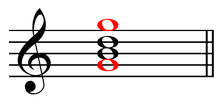G major
 | |
| Relative key | E minor |
|---|---|
| Parallel key | G minor |
| Dominant key | D major |
| Subdominant | C major |
| Component pitches | |
| G, A, B, C, D, E, F♯, G | |
G major (or the key of G) is a major scale based on G, with the pitches G, A, B, C, D, E, and F♯. Its key signature has one sharp, F♯.
G major's relative minor is E minor, and its parallel minor is G minor.
For orchestral works in G major, the timpani are typically set to G and D, a fifth apart, rather than a fourth apart as for most other keys.
Notable compositions
Baroque period
- In the Baroque era, G major was regarded as the "key of benediction".[1]
- Of Domenico Scarlatti's 555 keyboard sonatas, G major is the home key for 69, or 12.4% – about 50% more than the 8.3% one would expect in an even distribution.
- In the music of Johann Sebastian Bach, "G major is often a key of 6
8 chain rhythms", according to Alfred Einstein,[2] although Bach also used the key for some 4
4-based works, including his third and fourth Brandenburg Concertos. Pianist Jeremy Denk observes that the Goldberg Variations are 80 minutes in G major.[3]
Classical era
- Twelve of Joseph Haydn's 104 Symphonies (11.5%, 1.4 times more than in an even distribution) are in G major. See also: List of symphonies in G major. Likewise one of Haydn's most famous piano trios, No. 39 (with the Gypsy Rondo), and one of his last two complete published string quartets (Op. 77, No. 1), are in G major.
- G major is the home key of Mozart's Eine kleine Nachtmusik, serving as the tonic for three of its four movements (the exception being the second movement, titled Romanze and is in the subdominant key). However, almost none of his large-scale works such as his symphonies or concertos are in this key; exceptions are the Piano Concerto No. 17, Flute Concerto No. 1 and his String Quartet No. 14, along with some examples among his juvenilia.
In popular culture
G sometimes called the 'people's key', is one of the most frequently-employed keys across classical and popular music. This is in part because of its relative ease of playing on both keyboard and string instruments: its scale includes only one black note on the keyboard, all of a guitar's six strings can be played open in G, half of the strings on the mandolin and violin/fiddle are in the G chord when open, and the banjo is usually tuned to open G. It is the key stipulated by Queen Elizabeth II to be used for "God Save the Queen" in Canada.[4] The music to the American national anthem, "The Star-Spangled Banner", was originally written in G major. Though it is now usually sung in A-flat or B-flat major, some people, most notably humorist and commentator Garrison Keillor, are campaigning[5] to return the song to its original key; they argue that the song is already very difficult to sing on account of its range (one and a half octaves), and the modern standard key makes it still more difficult. God Defend New Zealand was originally composed by John Joseph Woods in A-flat, but after becoming New Zealand's national anthem in 1977 was rearranged into G to better suit general and massed singing.[6]
See also
References
- ↑ Mellers, Wilfred (8 April 1991), "Modernism's Child", The New Republic, 204 (14): 38–40
- ↑ Alfred Einstein, Mozart, His Character, His Work, Chapter 10, "Mozart's Choice Of Keys"
- ↑ Why I hate the Goldberg Variations
- ↑ Department of National Defence: The Honours, Flags and Heritage Structure of the Canadian Forces; p. 7–2
- ↑ http://prairiehome.publicradio.org/features/deskofgk/2004/07/02_starspangled.shtml
- ↑ "Musical score for God Defend New Zealand". Ministry of Culture and Heritage / Manatū Taonga. Retrieved 10 May 2016.
External links
 Media related to G major at Wikimedia Commons
Media related to G major at Wikimedia Commons
| Diatonic scales and keys | |||||||||||||||||||||||||||||||||||||||||||||||||||||||
|---|---|---|---|---|---|---|---|---|---|---|---|---|---|---|---|---|---|---|---|---|---|---|---|---|---|---|---|---|---|---|---|---|---|---|---|---|---|---|---|---|---|---|---|---|---|---|---|---|---|---|---|---|---|---|---|
 |
| ||||||||||||||||||||||||||||||||||||||||||||||||||||||
| The table indicates the number of sharps or flats in each scale. Minor scales are written in lower case. | |||||||||||||||||||||||||||||||||||||||||||||||||||||||
